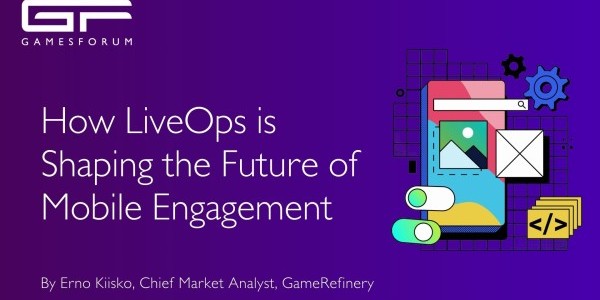Risk, Reward, Rentention - The CFO’s Guide to Hybrid Monetization With Kalahari Studios

Jón F. Thoroddsen has worn both the startup scrappy hat and the corporate finance suit — and in mobile gaming, that mix matters. As CFO of Corsa and Chairman of the Board at Kalahari Studios, he knows that structuring hybrid monetization isn’t just about squeezing revenue; it’s about balancing risk, reward, and player trust, much like any smart portfolio.
In this conversation, ahead of his appearance at Gamesforum London, Jón shares how lessons from corporate finance shape smarter, more sustainable monetization strategies for mobile games.
You’ve worked across both startups and established companies - what lessons from corporate finance are most applicable when structuring hybrid monetization strategies for mobile games?
To begin, it's essential to recognize that the key lesson from corporate finance when structuring hybrid monetization strategies for mobile games is the importance of diversification. Relying heavily on a single revenue stream exposes the business to significant risk, as fluctuations in user behavior or market conditions can jeopardize the entire model. For example, a game that depends solely on in-app purchases (IAPs) will face challenges if most players choose not to spend, while an overreliance on ads can alienate users and harm engagement if not implemented thoughtfully.
Just as in business economics 101, where companies are taught to balance fixed and variable income, game studios should aim for a hybrid approach. Ads can provide a more stable, predictable baseline revenue (similar to fixed income), while IAPs represent higher-yield but more volatile revenue (similar to variable income). In short, hybrid monetization in games mirrors good financial management: don’t rely on a single stream, balance stability with upside, and adapt strategies as the market evolves.
Many studios rely heavily on either IAPs or ads. From your experience, what are the risks of overdependence on a single revenue stream, and how can studios balance their models more effectively?
From my experience, adopting a hybrid approach that combines both IAPs, advertising and other monetization forms, offers a more robust and sustainable revenue foundation. This strategy allows developers to monetize different player segments—those willing to spend and those who prefer free gameplay—thereby reducing reliance on any one source. By integrating these revenue streams strategically and tailoring them to user behavior, studios can achieve a balanced, resilient business model that maximizes lifetime value across diverse player types.
In short, diversification not only reduces risk but also ensures players with different behaviors can all contribute to the game’s success.
Hybrid monetization often requires a careful balance between user experience and revenue generation. How do you measure the point where monetization risks harming player retention?
Hybrid monetization is always about balance — too little and the game isn’t sustainable, too much and players churn. From my experience in both startups and established companies, the key is applying the same discipline you’d use in finance: diversify revenue streams, but never at the expense of long-term value.
To measure the point where monetization risks harming player retention, I am learning to rely on a mix of behavioral metrics and player feedback. Metrics like session length, churn rates, and DAU/MAU ratios are early warning signs — if engagement dips after introducing a monetization feature, it’s a strong signal the balance isn’t right. Similarly, tracking ad impressions per user per day helps spot when ads are crossing the line from value-add to intrusive.
Beyond the data, I believe that playtesting is always critical. They reveal whether players feel over-monetized, or whether monetization is integrated in a way that feels natural and even rewarding.
In short, the balance comes from respecting the player: use clear data to spot when engagement is dropping, listen to feedback, and adapt monetization strategies before short-term revenue damages long-term trust.
In short, the most reliable metrics are those that show both financial efficiency and player health. If retention and LTV are strong, and monetization changes improve ARPU or ROAS without spiking churn, that’s a good signal to scale. But if the data shows gains in one area at the cost of long-term engagement, that’s when restraint is needed.
Looking at the current mobile gaming market, which underexplored monetization channels do you believe hold the greatest potential in the next 12–18 months?
In the next 12–18 months, I believe some of the most promising but underexplored monetization channels in mobile gaming will come from models that sit between pure ads and pure IAPs. Rewarded ads are a great example — they’ve become increasingly popular because they let non-paying players engage in monetization while enhancing rather than disrupting gameplay. When combined with other revenue streams, they provide a scalable and player-friendly baseline income.
From a personal perspective, at Kalahari Studios, we will launch our first title in Q1 2026 and our second title later in 2026. Both are built around a three-tier monetization model: subscriptions, rewarded/other ad/brand formats, and in-app purchases (IAPs). Subscriptions help establish predictable recurring revenue, ads ensure monetization from a broader audience, and IAPs deliver higher-yield revenue from engaged spenders.
Looking ahead, I also see strong potential in season-based passes, loyalty-driven rewards, and more brand partnerships in various forms. These approaches can deepen engagement, spread risk across different channels, and create new ways for players to interact with games beyond the traditional ad-or-IAP split.
In short, the next wave of monetization will be about blending recurring, scalable, and high-yield streams into balanced models that both sustain the business and feel natural to the player experience.
As someone who has led both game development and financial operations, how do you ensure monetization strategies are aligned with long-term creative and brand goals?
I believe monetization should always support the game’s creative vision and brand rather than disrupt it. Having led both development and finance, I see monetization as both a design challenge and a financial strategy: diversify revenue, but integrate it so it feels natural to the player experience.
At Kalahari Studios, with our first two titles, we’ve built a three-stream model — subscriptions, ads/brand partnership, and IAPs — and we aim to ensure that monetization both complements gameplay and strengthens the overall player experience. By protecting the brand and respecting the player, we create strategies that drive long-term revenue and long-term trust.
In emerging markets, payment infrastructure and user behavior can be very different from Western markets. How should developers adapt their monetization strategies in these regions?
I wouldn’t call myself an expert in emerging markets, but I try to learn by following those who are. What’s clear is that player behavior can be very different. The key is to stay flexible, monitor data, adapt pricing and monetization formats to local habits, and avoid a one-size-fits-all approach.
Hybrid monetization relies heavily on data. What financial or behavioural metrics do you consider most reliable when evaluating whether to introduce or scale a new monetization method?
On the behavioural side, they say that retention rates (D1, D7, D30) are essential. If a game can’t keep players, no monetization method will scale successfully. I also watch churn rate and the DAU/MAU ratio, which show how sticky the experience is and whether monetization mechanics are encouraging or discouraging engagement. In practice, I’d evaluate new monetization methods first in soft launch markets through A/B testing. By tracking how LTV, retention, and ARPU shift across different cohorts, it becomes clearer whether a new mechanic (e.g., a subscription pass or rewarded ad placement) adds value or harms the experience. The goal isn’t just higher revenue in isolation, but sustainable monetization that doesn’t erode trust or player satisfaction.)
In short, the most reliable metrics are those that show both financial efficiency and player health. If retention and LTV are strong, and monetization changes improve ARPU or ROAS without spiking churn, that’s a good signal to scale. But if the data shows gains in one area at the cost of long-term engagement, that’s when restraint is needed.
Finally, what are you most looking forward to discussing or learning at Gamesforum London, particularly around the future of revenue diversification in gaming?
What I’m most looking forward to at Gamesforum London is the chance to keep learning. The mobile industry is evolving so quickly, and I’m constantly trying to stay on top of new trends while making sure they align with our values and beliefs in the casual mobile space. It’s also a great opportunity to reconnect with friendly faces in the community and hear how others are tackling their challenges.
When it comes to revenue diversification, I’m especially excited to explore fresh approaches that go beyond the traditional IAP-and-ads split. Subscriptions — which we’re now implementing — rewarded formats, and new partnership models are opening up a lot of possibilities, and I’m eager to hear how other studios are experimenting. For me, it’s less about having all the answers and more about staying curious, learning from others, and hopefully sharing some of my own perspectives along the way.
Get your Gamesforum London tickets here













